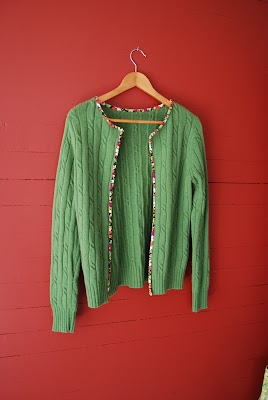Friday, March 26, 2010
Some thoughts on choosing knit fabrics
I get asked about knit fabrics a lot. I love working with knits, but they come with their own special challenges. Here are some thoughts that I have about choosing which knits you want to sew with, especially for t-shirts, knit dresses, and the camisole/panties sets.
When you purchase your fabric, buy at least 1/4 yard extra for shrinkage and practicing stretch stitches. Pre-wash your fabric as you intend to wash the finished garment. I wash and dry my fabric up to three times before cutting and sewing, just to be sure it won't shrink after I sew it!
Some thoughts on fabric:
There are many kinds of knit fabric on the market, including variances in content (cotton, poly, bamboo, hemp, wool, silk, lycra, etc.) and variances in how the fabric is made, which affects its stretch.
Knit patterns all have a stretch requirement. Fitted garments often require about 40% stretch. There is a line on the back of the pattern marked with a black box and white arrow. You can hold the fabric to the pattern, stretch it, and if it goes to the end of the black box/white arrow, it is stretchy enough to use. Don’t try to stretch the selvedge. Use the middle of the fabric and stretch away from (perpendicular to) the selvedge.
Interlock knits are knit in a special way so the fabric is double-sided, without right and wrong sides. It does not roll, is very easy to work with and I highly recommend it for your first t-shirt! It usually has a 30-40% stretch.
Jersey knits, also called single knits, are very common, fairly thin, and have a tendency to roll. They have an obvious right side and wrong side, just like hand knit items. The amount they roll can be a big challenge when you are cutting out and sewing the pattern. But the fabric has a lovely drape, with 25%-50% stretch. Those who are up for a challenge or who have a serger will find jersey knits very rewarding to sew.
Double knits aren’t just made from that awful polyester from the 70s. Now commonly found in 100% cotton or cotton blends, it is similar to interlock knits in that it doesn’t have a right or wrong side and does not roll. It is usually heavier weight than interlock and has minimal stretch. I wouldn’t recommend it for a t-shirt.
Rib knits are generally used for necklines and cuffs because they have 100% stretch – meaning 4” of ribbing will stretch to 8” and then rebound back to 4” when you let go of it. There are some rib knits that are very fine and delicate, making them good for a t-shirt. They do not have a right or wrong side and do not roll.
When you check the stretch of a fabric, don’t stretch the selvedge edge, but reach down a few inches and measure there. The selvedge will not stretch as much as the rest of the fabric. Stretch parallel to the selvedge and also perpendicular to the selvedge. One direction will stretch more than the other.
Bolt has a lot of very lovely knits. If you choose a stripe or a print, you might be surprised how easy it is to work with! Be sure to note the direction of the stripes! Imagine the selvedge edge running down the center of your shirt from neck to hem and make sure the stripes go the “right” direction for you!
When you purchase your fabric, buy at least 1/4 yard extra for shrinkage and practicing stretch stitches. Pre-wash your fabric as you intend to wash the finished garment. I wash and dry my fabric up to three times before cutting and sewing, just to be sure it won't shrink after I sew it!
Some thoughts on fabric:
There are many kinds of knit fabric on the market, including variances in content (cotton, poly, bamboo, hemp, wool, silk, lycra, etc.) and variances in how the fabric is made, which affects its stretch.
Knit patterns all have a stretch requirement. Fitted garments often require about 40% stretch. There is a line on the back of the pattern marked with a black box and white arrow. You can hold the fabric to the pattern, stretch it, and if it goes to the end of the black box/white arrow, it is stretchy enough to use. Don’t try to stretch the selvedge. Use the middle of the fabric and stretch away from (perpendicular to) the selvedge.
Interlock knits are knit in a special way so the fabric is double-sided, without right and wrong sides. It does not roll, is very easy to work with and I highly recommend it for your first t-shirt! It usually has a 30-40% stretch.
Jersey knits, also called single knits, are very common, fairly thin, and have a tendency to roll. They have an obvious right side and wrong side, just like hand knit items. The amount they roll can be a big challenge when you are cutting out and sewing the pattern. But the fabric has a lovely drape, with 25%-50% stretch. Those who are up for a challenge or who have a serger will find jersey knits very rewarding to sew.
Double knits aren’t just made from that awful polyester from the 70s. Now commonly found in 100% cotton or cotton blends, it is similar to interlock knits in that it doesn’t have a right or wrong side and does not roll. It is usually heavier weight than interlock and has minimal stretch. I wouldn’t recommend it for a t-shirt.
Rib knits are generally used for necklines and cuffs because they have 100% stretch – meaning 4” of ribbing will stretch to 8” and then rebound back to 4” when you let go of it. There are some rib knits that are very fine and delicate, making them good for a t-shirt. They do not have a right or wrong side and do not roll.
When you check the stretch of a fabric, don’t stretch the selvedge edge, but reach down a few inches and measure there. The selvedge will not stretch as much as the rest of the fabric. Stretch parallel to the selvedge and also perpendicular to the selvedge. One direction will stretch more than the other.
Bolt has a lot of very lovely knits. If you choose a stripe or a print, you might be surprised how easy it is to work with! Be sure to note the direction of the stripes! Imagine the selvedge edge running down the center of your shirt from neck to hem and make sure the stripes go the “right” direction for you!
That shirt on your back...
...did you make it yourself?
Well you CAN!
We've opened YET ANOTHER t-shirt class!!!

This is getting wild folks!
You can join the fun on Tuesday nights, April 6th and 13th,
7pm-9pm at Modern Domestic!
For those of you who want to make the Knit Dress

or the Camisole and Panties,
 you need to have made a t-shirt first.
you need to have made a t-shirt first.
Call Modern Domestic at 503-808-9910 to sign up, or go to their website and you can sign up online!
We've opened YET ANOTHER t-shirt class!!!

This is getting wild folks!
You can join the fun on Tuesday nights, April 6th and 13th,
7pm-9pm at Modern Domestic!
For those of you who want to make the Knit Dress

or the Camisole and Panties,
 you need to have made a t-shirt first.
you need to have made a t-shirt first.Call Modern Domestic at 503-808-9910 to sign up, or go to their website and you can sign up online!
Monday, March 22, 2010
T-shirt mania
The T-shirt class that I am teaching at Modern Domestic is almost full. So in addition to the April 11th class (noon-4pm) we are opening another session of the class on May 23rd (also noon-4pm). Come take the class and make a t-shirt in a day!
You have your choice of the Women's tee (nicely fitted, seen below) and the new Men's tee. Both patterns come with 27 sizes (children's sizes through adult sizes), so you can make any size t-shirt you want!

Note to self: get dress form. Our hangers are too wide.
You have your choice of the Women's tee (nicely fitted, seen below) and the new Men's tee. Both patterns come with 27 sizes (children's sizes through adult sizes), so you can make any size t-shirt you want!

Note to self: get dress form. Our hangers are too wide.

Next note to self: make another sample for Modern Domestic, so this here shirt can be on my body, not on display!
I'm loving the mock v-neck that I did here. I wanted the stripes to line up, so I played with it a bit. Come to CLASS to find out how to do it!
Friday, March 19, 2010
Camisole and Pantie Set

So, with DIY going under-cover, so to speak, I figured it was high time to teach a class on making your own undergarments.

Learn to sew on picot edge elastic and stretch lace. Handle knit fabrics with ease!
Modern Domestic
Sunday, May 16th Noon-4pm
Thursday, March 18, 2010
Choose your own adventure

Knit dress. (I should have modeled it, it's way cuter on a person!)
Make your own at Modern Domestic! We will be using the Built by Wendy book, Sew U Home Stretch (at Amazon(dot)com for $10 right now!). I just finished reading through the whole book and it's really a good one. All you need to know about sewing on knit fabrics, without too many details to confuse. And it comes with a lot of basic patterns.
Class will be held Sundays, April 18th and 25th, 2pm-4pm.
We will spend the first day of class drafting the pattern for the dress you choose. You decide sleeve length, neckline (boat, scoop, v-neck), waistline (empire, regular, lowered), and skirt (gathered or not, flared or straight, long or short). And of course you get to choose your fabric and optional trim for a dress that is truly you. How lucky!
If you have successfully made something else out of knit fabric, come join us!
New to knits? Take the t-shirt class that is offered April 11th, 12pm-4pm.
Wednesday, March 17, 2010
Going Green

I had a turtle neck with a very scratchy neck. It was some nylon/wool/angora/cashmere (ha!) blend. And everytime I put it on, it drove me nuts. But I needed something green for St. Patrick's Day, right? So I cut off the neck and cut down the center front. I applied some knit scraps that I had. I cut two inch wide strips on the straight of grain (so it wouldn't stretch much and get all wavy). I folded the strips in half lengthwise and with the raw edge of the sweater lined up with the raw edges of the knit, sewed it on. I folded it to the back and stitched it down.
Subscribe to:
Comments (Atom)







